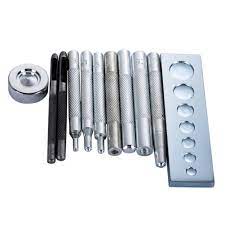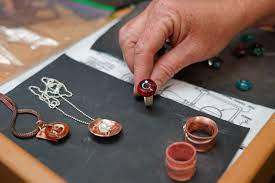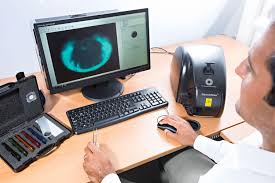Metal Setter (Basic)
SECTOR: GEMS & JEWELLERY
SUB-SECTOR: Cast and Diamond-Set Jewellery
OCCUPATION: Metal setting
REFERENCE ID: G&J/Q3103
ALIGNED TO: NCO-2004/7313.30
Metal setter (basic): Metal setter is also known as ‘Setter’ in Indian jewellery
making industry. In the cast and diamond-set jewellery manufacturing, metal
setting is considered a skilled job.
Brief Job Description: The individual works with numerous hand and machine
tools to set diamond and gemstones as per design, and is responsible for
delivering: levelled, damage-free and secured setting of stones while
maintaining its brilliance.
Personal Attributes: The job requires the individual to have: attention to
details; good eyesight; steady hands and ability to work in a process driven
team for long hours in sitting position. The individual is expected to have
integrity in dealing with precious metal, diamonds and gemstones.
Set diamond and gemstones in precious metal jewellery piece
Unit Code G&J/N3101
Unit Title
(Task) Set diamond and gemstones in the precious metal jewellery piece
Description This unit is about securely setting diamonds and gemstones in the precious metal
jewellery frames in a way that enhances brilliance of the stones
Scope This unit/task covers the following:
Collect the job sheet and raw materials
understand design specifications and information given in the job sheet in terms of
type of jewellery, diamonds and gemstones required and their weight
match the size and shape of the diamonds and gemstones received from
supervisor against the job sheet
assess the type of setting required, e.g., prong, channel, bead, flush, bezel and precut pave as per design of the jewellery and stone shape
Prepare jewellery frame for setting
set jewellery frame on lac plate or a ring clamp or a holding plate
check the fit and seat the jewellery frame
Set the stones in the collet
use burrs to grind the seat as per design
place the stone into the collet
press and level the stones with the pusher
tighten metal for secure setting of stone file edges to finish the prongs or channel
borders as per design
file and smoothen edges to avoid snagging to fabric
Control precious metal loss and damage to stones
collect metal dispersed during the day (dust and fragments)
report metal losses via documentation as per company policy
tally account as per allowed standards for the design
conduct regular and controlled environment cleaning for collection of metal dust
minimise metal loss below the prescribed limits
report any incidents of high precious metal loss
suggest improvements in order to reduce precious metal loss
handle diamonds and precious stones with care
minimise or avoid damage to the diamonds and precious stones
wash hands at the specified wash basin as per the company’s policy
Send jewellery piece for QC
ensure finishing of the prongs or channels and surface of the cast jewellery frame
as per design
ensure levelling of the stone set at the level as per design
ensure no diamonds or gemstones are loose
rework on any suggested QC correction or setting defects
Set diamond and gemstones in precious metal jewellery piece
after receiving QC approval, forward metal frame for final polishing
Keep the work environment clean and organised
keep the work station, machine and tools clean
keep all the tools in an organised manner
do not litter or spit on work premises
Report problems to supervisor about:
any mismatch in diamond and gemstone sizes and numbers issued to them
damage because of mishandling of stone
any casting defects such as porosity, blisters, bubbles, cracks, in the frame
Performance Criteria(PC) w.r.t. the Scope
Element Performance Criteria
Metal Setting To be competent, the user/individual on the job must be able to:
PC1. place or fix stone as per design requirement
PC2. secure stone in a jewellery piece without any defect or damage, with brilliance
intact
PC3. file edges ensuring smooth surface and utility of wearing
Productivity To be competent, the user/individual on the job must be able to:
PC4. maintain precious metal and stone loss within prescribed limit for the design
PC5. complete the number of settings as per the target
Quality of output To be competent, the user/individual on the job must be able to:
PC6. deliver on time, the metal-set jewellery for final polish and plating or for the
further processing as per work flow
PC7. Accurately level the stones
PC8. set the stones firmly
PC9. achieve setting finish as per design
Knowledge and Understanding (K)
A. Organizational
Context
The user/individual on the job needs to know and understand:
KA1. company’s policies on: acceptable limits of precious metal loss, incentives,
quality and delivery standards, safety and hazards, integrity and IPR, and
personnel management
KA2. work flow involved in jewellery manufacturing process of the company
KA3. importance of the individual’s role in the workflow
KA4. reporting structure
B. Technical
Knowledge
The user/individual on the job needs to know and understand:
KB1. shape, cut, clarity, carat, weight and physical characteristics of the gemstone
or diamond to be set
KB2. different types of setting styles such as prong, bezel, bead, channel and precut pave
KB3. quality standards required as per design or company policy
KB4. matching stones with the design
KB5. layout of the frame and collet
KB6. uses of different types of tools for different end results
KB7. sharpening and repair of tools for the job
KB8. potential work hazards, particularly, when using hand and machine tools
Skills (S) [Optional]
A. Core Skills/
Generic Skills
Basic reading and writing skills
The user/ individual on the job needs to know and understand how to:
SA1. read and interpret job sheets
SA2. read company policies and compliance documents required to complete the
work such as security check, timings, and human behaviour
Measuring and counting skills
The user/individual on the job needs to know and understand how to:
SA3. measure diamond and gemstones size by gauge tool or vernier calipers
SA4. count the number of the diamond and gemstones
Teamwork
The user/individual on the job needs to know and understand how to:
SA5. share work load as required
SA6. interpret the design instructions given by co-worker and supervisor
SA7. share knowledge with the co-workers
B. Professional Skills Reading design
The user/individual on the job needs to know and understand how to:
SB1. read design or actual jewellery sample piece and correlate with job sheet in
order to achieve secure setting as well as maintain brilliance of stones
Using hand and machine tools
The user/individual on the job needs to know and understand how to:
SB2. work with metals including how to cut, give shape for preparing a seat for
setting diamond and/or gemstones
SB3. use following key tools for metal setting:
hammers
tweezers
screw drivers
pliers
scribers
broaches and pin punches
center punches
hand-held burnishes and scrapers
high-speed steel burrs
carbide burrs and drills
twist drills
burr storage, lubricants and drill gauges
mill grain tools
prong lifters
work holders
hand pieces
flex shaft
gauges
magnifiers
pushers
SB4. maintain, repair and customise tools
SB5. work in a safe environment, i.e., without injuries
Reflective thinking
The user/individual on the job needs to know and understand how to:
SB6. use correct posture while performing the job of the setting
SB7. place the tools on the work bench for effective work management
SB8. ensure proper lighting is focussed for performance of the job
SB9. improve productivity
Critical thinking
The user/individual on the job needs to know and understand how to:
SB10. increase efficiency based on past working experience
Respect and maintain IPR
G&J/N9901
Unit Title
(Task) Maintain IPR of company and respect IPR of other companies
Description This OS unit is about protecting company’s IPR and avoiding infringement to IPR of
other companies
Scope This unit/task covers the following:
Protect company’s Intellectual Property Rights (IPR)
prevent leak of new designs to competitors by reporting on time
be aware of any of company’s product or design patents
report IPR violations observed in the market, to supervisor or company heads
Avoid infringement to IPR of other companies
read copyright clause of the material published on the internet and any other
printed material
consult supervisor or senior management when in doubt about using publicly
available information
report any infringement observed in the company
Performance Criteria(PC) w.r.t. the Scope
Element Performance Criteria
Respecting and
Maintaining IPR
To be competent, the user/individual on the job must:
PC1. be able to spot plagiarism and report
PC2. be aware of patents and IPR
PC3. not be involved in IPR violations
Knowledge and Understanding (K)
A. Organizational
Context
The user/individual on the job needs to know and understand:
KA1. company’s policies on IPR and plagiarism
KA2. reporting structure
KA3. company’s unique product range
B. Technical
Knowledge
The user/individual on the job needs to know and understand:
KB1. patents and IPR laws
KB2. how IPR protection is important for competitiveness of a company
Skills (S) [Optional]
A. Core Skills/
Generic Skills
Communication skills
The user/ individual on the job needs to know and understand how to:
SA1. effectively communicate any observed IPR violations or order leaks
B. Professional Skills Decision making
The user/individual on the job needs to know and understand how to:
SB1. report potential sources of violations
Reflective thinking
The user/individual on the job needs to know and understand to:
SB2. learn from past mistakes and report IPR violations on time
Critical thinking
The user/individual on the job needs to know and understand how to:
SB3. spot signs of violations and alert authorities in time
Unit Code G&J/N9902
Unit Title
(Task) Interact with colleagues and seniors
Description This OS unit is about communicating with colleagues and seniors in order to achieve
smooth and hazard-free work flow
Scope This unit/task covers the following:
Interact with supervisor
receive work instructions and raw materials from reporting supervisor
communicate to reporting supervisor about process-flow improvements, product
defects received from previous process, repairs and maintenance of tools and
machinery as required
communicate any potential hazards or expected process disruptions
handover completed work to supervisor
Interact with colleagues within and outside the department
work as a team with colleagues and share work as per their or own work load and
skills
work with colleagues of other departments
communicate an discuss work flow related difficulties in order to find solutions
with mutual agreement
receive feedback from QC and rework in order to complete work on time
Performance Criteria(PC) w.r.t. the Scope
Element Performance Criteria
Interaction with
supervisor
To be competent, the user/individual on the job must be able to:
PC1. understand the work output requirements
PC2. comply with company policy and rule
PC3. deliver quality work on time as required by reporting any anticipated reasons
for delays
Interactions with
colleagues and other
departments
To be competent, the user/individual on the job must be able to:
PC4. put team over individual goals
PC5. be able to resolve conflicts
PC6. learn how to multi-task relevant activities
Knowledge and Understanding (K)
A. Organizational
Context
The user/individual on the job needs to know and understand:
KA1. company’s policies on: preferred language of communication, reporting and
escalation policy, quality delivery standards, and personnel management
KA2. reporting structure
B. Technical
Knowledge
The user/individual on the job needs to know and understand how to:
KB1. communicate effectively
KB2. build team coordination
Skills (S) [Optional]
A. Core Skills/
Generic Skills
Communication skills
The individual on the job needs to know and understand how to:
SA1. read and write preferred language of communication as prescribed by the
company
SA2. read job sheets and interpret technical details mentioned in the job sheet
B. Professional Skills Decision making
The individual on the job needs to know and understand:
SB1. how to spot and communicate potential areas of disruptions to work process
and report the same
SB2. when to report to supervisor and when to deal with a colleague individually,
depending on the type of concern
Reflective thinking
The individual on the job needs to know and understand how to:
SB3. improve work processes by interacting with others and adopting best practices
Critical thinking
The individual on the job needs know and understand how to:
SB4. spot process disruptions and delays and report and communicate with
solutions
Maintain occupational health and safety
Unit Code G&J/N9905
Unit Title
(Task) Maintain occupational health and safety
Description This OS unit is about being aware of, communicating and taking steps towards
minimizing potential hazards and dangers of accidents on the job and maintaining
occupational health and safety
Scope This unit/task covers the following:
Understand potential sources of accidents
to avoid accidents related to use of potentially dangerous chemicals, sharp tools,
hazards from machines and such as heating lamps
Use safety gear to avoid accidents
wear safety gear such as goggles, mask, gloves, ear plugs
Actively participate in the health and safety awareness campaigns
attend fire drills organised by the company or industrial zone
learn first aid procedure
be alert about designated assembly area in the event of an emergency
read and understand the evacuation and emergency procedures
Communicate to reporting supervisor about:
process flow improvements that can reduce anticipated or repetitive hazards
mishandling of tools, machines or hazardous materials
electrical problems that could result in accident
Performance Criteria(PC) w.r.t. the Scope
Element Performance Criteria
Communicating
potential accident
points
To be competent, the user/individual on the job must be able to:
PC1. spot and report potential hazards on time
PC2. follow company policy and rules regarding use of hazardous materials
PC3. attend and actively participate in the health and safety campaigns organised
by the company
Using safety gear To be competent, the user/individual on the job must be able to:
PC4. use or wear safety gear as per the rules of the company
Knowledge and Understanding (K)
A. Organizational
Context
The user/individual on the job needs to know and understand:
KA1. company’s policies on: safety and hazards and personnel management
KA2. reporting structure
B. Technical
Knowledge
The user/individual on the job needs to know and understand:
KB1. how different chemicals react and what could be the danger from them
KB2. how to use machines and tools without suffering bodily harm
Maintain occupational health and safety
A. Core Skills/
Generic Skills
Communication skills
The individual on the job needs to know and understand how to:
SA1. effectively communicate the danger
Organising skills
The individual on the job needs to know and understand how to:
SA2. keep all the tools in an organised manner so as to avoid accidents
SA3. keep the work environment safe and clean
B. Professional Skills Decision making
The individual on the job needs to know and understand how to:
SB1. report potential sources of danger
SB2. follow prescribed procedure in the event of an accident
SB3. wear appropriate safety gear to avoid an accident
Reflective thinking
The individual on the job needs to know and understand to:
SB4. learn from past mistakes regarding use of hazardous machines or chemicals
Critical thinking
The individual on the job needs to know and understand how to:
SB5. spot danger
Decision making
The individual on the job needs to know and understand how to:
SB6. report potential sources of danger
SB7. follow prescribed procedure in the event of an accident
SB8. wear appropriate safety gear to avoid an accident
Qualifications Pack for Metal Setter
Keywords /Terms Description
Sector Sector is a conglomeration of different business operations having similar
business and interests. It may also be defied as a distinct subset of the
economy whose components share similar characteristics and interests.
Sub-sector Sub-sector is derived from a further breakdown based on the
characteristics and interests of its components.
Occupation Occupation is a set of job roles, which perform similar/ related set of
functions in an industry.
Function Function is an activity necessary for achieving the key purpose of the
sector, occupation, or an area of work, which can be carried out by a
person or a group of persons. Functions are identified through functional
analysis and form the basis of OS.
Sub-function Sub-functions are sub-activities essential to fulfil the achieving the
objectives of the function.
Job role Job role defines a unique set of functions that together form a unique
employment opportunity in an organisation.
Occupational Standards
(OS)
OS specify the standards of performance an individual must achieve
when carrying out a function in the workplace, together with the
knowledge and understanding they need to meet that standard
consistently. Occupational Standards are applicable both in the Indian
and global contexts.
Performance Criteria Performance criteria are statements that together specify the standard of
performance required when carrying out a task.
National Occupational
Standards (OS)
NOS are occupational standards which apply uniquely in the Indian
context.
Qualifications Pack (QP) QP comprises the set of OS, together with the educational, training and
other criteria required to perform a job role. A QP is assigned a unique
qualifications pack code.
Unit Code Unit code is a unique identifier for an Occupational Standard, which is
denoted by an ‘N’
Unit Title Unit title gives a clear overall statement about what the incumbent
should be able to do.
Description Description gives a short summary of the unit content. This would be
helpful to anyone searching on a database to verify that this is the
appropriate OS they are looking for.
Scope Scope is a set of statements specifying the range of variables that an
individual may have to deal with in carrying out the function which have
a critical impact on quality of performance required.
Knowledge and
Understanding
Knowledge and understanding are statements which together specify the
technical, generic, professional and organisational specific knowledge
that an individual needs in order to perform to the required standard.
Organisational Context Organisational context includes the way the organisation is structured
and how it operates, including the extent of operative knowledge
managers have of their relevant areas of responsibility.
Technical Knowledge Technical knowledge is the specific knowledge needed to accomplish
specific designated responsibilities.
Core Skills/ Generic
Skills
Core skills or generic skills are a group of skills that are the key to learning
and working in today’s world. These skills are typically needed in any
work environment in today’s world. These skills are typically needed in
any work environment. In the context of the OS, these include
communication related skills that are applicable to most job roles.
Keywords /Terms Description
IPR Intellectual Property Rights
Mohs Mohs scale of mineral hardness
NOS National Occupational Standard(s)
NSQF National Qualifications Framework
NVEQF National Vocational Education Qualifications Framework
NVQF National Vocational Qualifications Framework
QP Qualifications Pack
CRITERIA FOR ASSESSMENT OF TRAINEES
Job Role Metal Setter (Basic)
Qualification Pack G&J/Q3103
Sector Skill Council Gem & Jewellery
Guidelines for Assessment
- Criteria for assessment for each Qualification Pack will be created by the Sector Skill Council. Each
Performance Criteria (PC) will be assigned marks proportional to its importance in NOS. SSC will also lay down
proportion of marks for Theory and Skills Practical for each PC. - The assessment for the theory part will be based on knowledge bank of questions created by the SSC.
- Individual assessment agencies will create theory question papers for candidates at every
examination/training centre. (as per assessment criteria below) - Individual assessment agencies will create practical tests for skill evaluation for candidates at every
examination/training centre. (as per assessment criteria below) - To pass the Qualification Pack, every candidate should score a minimum of 50% in theory and 70% in
practical to successfully clear the assessment. - In case of successfully passing only certain number of NOS’s, the candidate is eligible to take subsequent
assessment on the balance NOS’s to pass the Qualification Pack.









